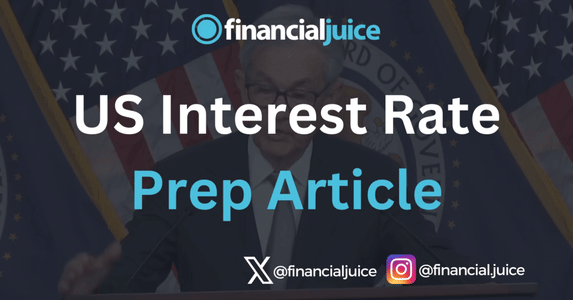
US Interest Rate Prep
On Wednesday the 31st of January at 14:00 ET, the Federal Reserve is set to release its latest interest rate decision.
According to the CME Fedwatch tool, as of 09:00 AM ET Monday, January 29th, there is a 97.9% chance of no change at this meeting for the fourth consecutive time.
So attention will turn to the Rate Statement and Press Conference for comments to give any ideas on how data and current global events are influencing future Fed decision-making.
Regardless, here are some views on what to expect.
Commentary
UniCredit
The FOMC will likely keep the target range for the federal funds rate steady at 5.25-5.50% at the conclusion of its two-day meeting on 31 January.
At the December FOMC meeting, Fed Chair Powell said the committee had begun to discuss when it might be appropriate to cut rates, and the Summary of Economic Projections (SEP) indicated three 25bp rate cuts for this year.
But recent remarks by Fed officials suggest they are in no hurry to cut rates.
While inflation has fallen sharply, Fed officials want to see further evidence of easing inflationary pressures in the coming months to be confident that inflation will return to 2% on a sustained basis.
Unlike past rate-cutting cycles, when the economy had typically tipped into recession, Fed officials judge that this time they can afford to proceed carefully with rate cuts, given the resilience of activity and employment.
There will be no new SEP at this meeting, so investors will only have the post-meeting statement and Chair Powell’s press conference to scrutinize.
The statement is likely to keep the line, “In determining the extent of any additional policy firming that may be appropriate”, if only for fear of adding fuel to the recent easing in financial conditions (the base case of all FOMC participants is that the next move for rates will be down).
We continue to expect the first rate cut in June and a total of 125bp of cuts this year (broadly in line with current market expectations).
Morgan Stanley
We expect the FOMC to remain on hold.
We continue to expect 100bp of cuts this year, beginning in June.
The Fed cuts by an additional 200bp in 2025, returning policy to a neutral setting.
We expect little change in the FOMC statement as the Fed awaits direction from important revisions to employment and inflation in early February.
Societe Generale
The outcome of the January FOMC meeting is for unchanged rates, and modest changes to the statement. It is the guidance for March and beyond that is crucial for investors.
Market expectations for a March rate cut receded from near-certainty in early January to more of a 50/50 outcome at the time of this writing.
The Fed is very likely to cut rates in 2024, but precisely when and by how much remains unknown. Markets are pricing in a 50/50 probability for a rate cut in March.
From our reading, that is earlier than the Fed might desire, but if data dependency is the true determinant, Chair Powell should not commit to any timing, which includes not ruling out a March cut.
The FOMC summary of economic projections showed a median expectation of 75bp in rate cuts in 2024, while the market anticipates up to 150-175bp.
Fed Chair Powell in his press conference may discuss confidence in inflation reaching and sustaining a 2% goal as conditions for cuts.
Dependency on incoming data should be stressed, but he should avoid commitments on early cuts and also waiting on any timeline for cuts.
The most likely outcome in our view is for markets to shift out their rate cut expectations to May and beyond.
Evidence on the economy in 4Q23, with GDP growth of 3.3%, remained stronger than expected.
Inflation – at least PCE inflation – is reaching 2%, but that alone is unlikely to usher in early and aggressive cuts.
JPMorgan
We believe the Fed is done raising rates and expect cuts to start in 3Q24, at a pace of 25bp per meeting, bringing the Fed funds rates to 3.5% by mid-2025.
First, while the policy rate tightening cycle has come to a conclusion, the balance sheet normalization cycle is ongoing in the background, with no end in sight.
Second, the ongoing rebalancing of Treasury demand toward more price-sensitive investors should translate into higher term premiums over time, which is consistent with steeper curves.
Bank of America
We expect the Fed to stay on hold at the January FOMC meeting and to change its policy rate guidance in the post-meeting statement to more neutral language.
This would be a de-facto easing bias since most Fed members have indicated the hiking cycle is likely over. In addition, the Fed can accelerate its discussion about when and how it should slow the pace of securities runoff from its balance sheet.
The Fed should be pleased with the overall state of the economy.
Labor markets have cooled, and inflation has come down more rapidly than expected absent a large rise in unemployment but we don’t think the Fed is ready to send a strong signal about its intentions just yet
Goldman Sachs
Heading into the January FOMC meeting, the market is priced for a close to 50% chance of a rate cut in March. We suspect that Fed officials are content with that and would prefer to keep market pricing roughly where it is in order to keep a March cut on the table.
The two key questions for the meeting are how the FOMC will revise the description of its policy intentions in its statement and how Chair Powell will respond to the inevitable questions about a possible March cut in his press conference.
We expect the FOMC to remove the now outdated hiking bias from its statement and replace it with language that opens the door to a March cut without decisively signaling it.
Specifically, the FOMC could revise its statement by borrowing language from the December minutes to note that it expects that it will “be appropriate for policy to remain at a restrictive stance until inflation is clearly moving down sustainably toward the Committee’s objective,” dropping the qualifier “for some time” that was included in the minutes to make it clear that a March cut is possible.
This language appears to have been carefully crafted to hint at eventual rate cuts without quite referring to them. Powell would then surely be asked whether he anticipates that threshold of inflation moving sustainably toward 2% will be met by the March meeting.
He would likely answer that any future adjustments to the policy stance will depend on upcoming inflation and other data, and that it is premature to decide on a March move now because there are still two rounds of monthly inflation data and the annual revisions to the CPI yet to come before the March meeting.
We continue to expect the FOMC to deliver three consecutive cuts in March, May, and June before slowing to a quarterly pace in Q3 and Q4, for a total of five cuts in 2024.
After Governor Waller’s speech, we noted that we now see the risks—barring any major negative shocks as tilted toward a slightly later start or a slightly slower pace, perhaps quarterly from the outset. Accounting for even our low probability of recession, however, implies that the risks around our baseline are roughly symmetric, so that our baseline and probability-weighted Fed forecasts remain roughly the same and roughly in line with current market pricing for just over five cuts this year.
Previous Release
On December 13th at 14:00 ET, the Federal Reserve kept rates unchanged for the third consecutive meeting, at 5.5%.

Due to the Summary of Economic Projections containing dovish content regarding the future of rate cuts in the US, stocks strengthened while the dollar and yields weakened.
“FOMC median forecast shows 75 bps of rate cuts in 2024 to 4.6%.”




